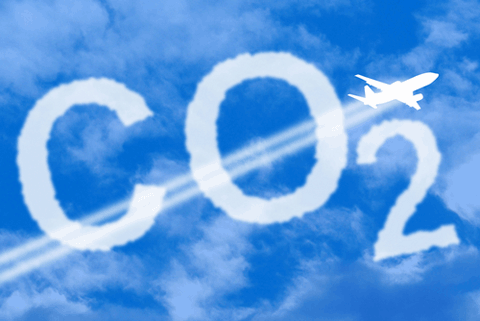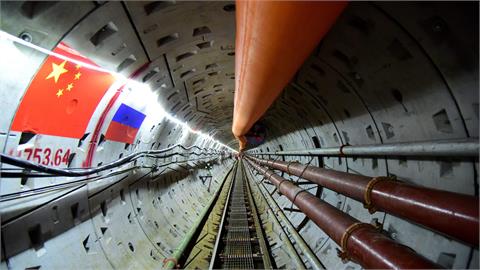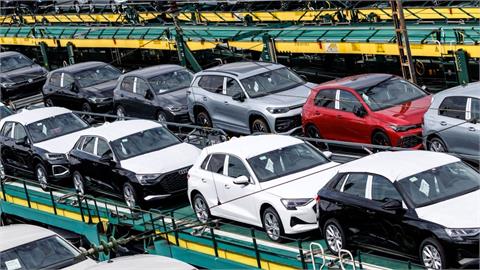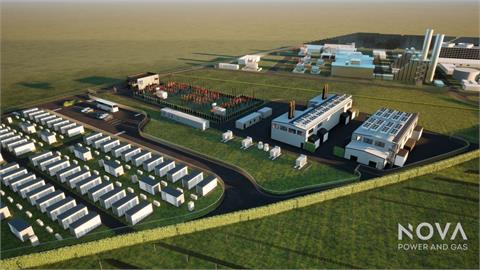In what appeared to be a rather desperate move lawmakers in Brussels went ahead last Tuesday (19/2) with action to shore up the sagging market for carbon emissions permits, a key component of the European Union efforts to curb the effects of Climate Change. The EU carbon market, known as the emissions trading system (ETS), is the world’s largest and the cornerstone of the bloc’s climate policy. It seeks to reduce the greenhouse gas emissions that contribute to global warming by requiring companies to pay for their pollution
In what appeared to be a rather desperate move lawmakers in Brussels went ahead last Tuesday (19/2) with action to shore up the sagging market for carbon emissions permits, a key component of the European Union efforts to curb the effects of Climate Change.
The EU carbon market, known as the emissions trading
system (ETS), is the world’s largest and the
cornerstone of the bloc’s climate policy. It seeks to
reduce the greenhouse gas emissions that contribute to global warming by
requiring companies to pay for their pollution. Proponents had hoped that a well-functioning market would give companies an
incentive to invest in green technologies while also serving as a model for
other nations to address climate change.
But the market, which with the highest of expectations was launched in 2005, has instead become an embarrassment as a glut of allowances has caused prices that once hovered around €30 per tonne to sink as low as €2.81 per tonne, calling into question the market’s viability. According to analysts the biggest culprit has been Europe’s economic crisis, which has damped industrial activity and reduced demand for allowances.
Prices of carbon allowances, which let companies emit greenhouse gases, fell last month to as low as 2.80 euros, or about $3.75, a metric ton, compared with 9 euros a ton a year ago and 30 euros a ton in 2008. To reduce the supply of permits and drive up the price, the environmental committee of the European Parliament voted a plan to allow the European Commission to reduce the number of allowances to be auctioned over the next three years.
 |
The plan, known as "backloading”, would postpone the auction of 900m carbon allowances in an attempt to ease the market’s oversupply. Members of the environment committee gave their backing last Tuesday by a margin of 38 to 25, with two abstentions. "The environment committee has sent a clear signal in favour of a strong and healthy emissions trading system. A stronger carbon price will help catalyse Europe’s transition towards a low-carbon economy,” said Euro MP. Matthias Groote, the committee chairman.
In spite of the positive ballot, the price of a carbon allowance quickly fell 20 per cent to a low of €4.09. It subsequently recovered to €4.58, still down more than 10 per cent. But the panel’s vote had been expected, and the plan still needs approval from the full European Parliament and the governments of the 27 member states. Some analysts attributed part of this decline to profit taking, after prices firmed us in the days ahead of the vote.
"It is really the first step in a long, long process,”
said Kash Burchett, an analyst at the energy research firm IHS. The committee’s
vote — 38 to 25, with two abstentions — is "a lifeline for the carbon market
and for emissions trading as a policy tool for curbing emissions,” said Stig
Schjoelset, head of carbon analysis at Thomson Reuters Point Carbon, a market
research firm in Oslo. If the vote had gone the other way, Mr. Schjoelset said,
the Emissions Trading System would have been "more or less dead.”
Under the EMS system, companies are allocated a certain number of permits, each allowing them to emit one metric ton of carbon dioxide each year. If emissions exceed the level allowed by the permits, the companies must buy additional permits. Noncompliance risks heavy fines.

The total number of permits is scheduled to be reduced over time, forcing a corresponding reduction in emissions. The European Union is on track to meet its goal of reducing emissions in 2020 to 80 percent of 1990 levels, but that is mainly because the recession has reduced industrial activity and energy use. As a result, companies have a surplus of permits on hand, which depresses their price.
It is widely thought that the European Commission has handed out too many credits. In 2012, for example, ArcelorMittal, the Luxembourg-based steel maker, sold 21.8 million tons of credits — about one quarter of the number it received from the commission — for $220 million. The company said it spent the proceeds on energy-saving investments.
Advocates say that carbon pricing, if properly managed, is the most efficient way to lower emissions. By putting a hefty price on carbon, the system lets the market, though investment decisions,drive emissions reductions rather than having governments dictate investment policies, in particular clean energy sources like solar or wind.
But industrialists and analysts say that single-digit prices for carbon permits do not provide sufficient incentive for companies to switch to cleaner fuels and energy-efficient technology. "Driving energy investments in Europe through a higher carbon price will lower costs,” said David Hone, the chief climate adviser to Royal Dutch Shell and the chairman of the International Emissions Trading Associations in Geneva. "That price signal isn’t there today.”
Mr. Schjoelset said a price of €30 to €40 per ton was needed to encourage electricity producers to switch from coal to natural gas, a cleaner fuel. He said it would take a price of €60 to €150 per ton to push utilities to invest in expensive carbon-reducing technologies like carbon capture and storage.
Politicians and analysts said the Euro Parliament committee’s vote might be the first step in restoring the credibility of the Emissions Trading System, which is still considered the world’s flagship carbon programme.
"It is important that we get this right, and the sooner we get it right the better,” the European climate action commissioner, Connie Hedegaard, said in an interview with New York Times last Monday.
The plan approved Tuesday would take 900 million tons of carbon credits that are now scheduled to be auctioned from 2013 to 2015 and "backload” them so they are auctioned in 2019 and 2020. That will put a dent in the surplus of carbon credits, which is estimated at two billion tons.
The
vote by the parliament’s environment committee had been closely anticipated
since the market collapsed late last month after the parliament’s industry committee rejected a plan Many also noted that Mr Groote had not garnered sufficient support from
MEPs to launch immediate negotiations with member states, which must also approve
backloading. He is expected to seek a mandate in yet another committee vote
next week.
"With today’s weak support, we see further delays as
likely,” Per Lekander, a UBS analyst, wrote to investors. A spokesman for Connie Hedegaard, the climate
commissioner, who has championed
intervention in the carbon market, welcomed the result but also acknowledged
the uncertainties ahead. "It’s not the end of the road,” he said. "The member
states still have to discuss and vote on the parliament’s proposal. But it’s an
important step.”
At least one member state, Poland, staunchly opposes intervention while Germany, whose vote may be pivotal, has been divided. The commission has billed backloading as a temporary fix for the carbon market before it can embark on more radical – and controversial – repairs, including the permanent withdrawal of allowances or tougher long-term targets for EU greenhouse gas reductions.
Making it more expensive to pollute by requiring companies to buy emissions permits is central to the EU's goal of reducing emissions by 20% in 2020 from 1990 levels. But it would also be an unwelcome drag on a struggling economy. Slowing industrial production and electricity consumption is linked to Europe's widespread economic troubles which have significantly decreased demand for permits in a market already burdened with oversupply. That has turned decision-making on the permit scheme into a tug of war between those most concerned with sparking growth and those arguing that the EU shouldn't lose sight of longer-term environmental goals.
"There is a disparity between the economic priorities and challenges that Europe is facing and reaching more aggressive emissions reductions," said Divya Reddy, a Washington-based analyst for Eurasia Group who follows climate change.
Among those arguing most loudly for the primacy of economic concerns is Poland. Polish Environment Minister Marcin Korolec said his government opposes any effort to increase the price of permits, saying that would make electricity more expensive and threaten the country's economy, which is experiencing a sharp slowdown in growth and rising unemployment. "The ETS was designed as a market mechanism. I believe that it should continue to be operated based on market rules," Mr. Korolec said.
European Parliament members have been discussing the matter and looking for compromises, a parliamentary aide said, adding that now that the measure has been approved by the environment committee, the full Parliament will have to vote on the plan—something likely to happen in the spring. In the unlikely event that the plan dies in parliament, the price of emissions permits would probably fall below €1 per ton and the market would cease to act as a serious long-term deterrent to polluting, according to Virtuse Group Suisse, a trader of the allowances.
The ETS Scheme in SE Europe
Greece, Bulgaria, Romania and Croatia, all EU member countries, participate in EU’s ETS mechanism having obtained allocations of emission allowances (see table). Serbia is also going to join soon the ETS scheme as a candidate Member State. Implementation of ETS require specific actions in legislation, institutional development, capacity building, analysis, and awareness raising, note government sources in Belgrade. Other countries in the Balkans including Montenegro do not appear that ready or willing to join the ETS mechanism. Energy Community Sources in Vienna say that concrete steps are needed to gradually move towards adjusting a GHG reduction targets in order to be able to implement EU climate acquis, especially the EU Emissions Trading Scheme in the Balkans. On the other hand Turkey appears more ready as it recently announced legislation for building its capacity for monitoring, reporting and verification of emission data – a system known as MRV. The MRV law will take effect in 2014 and will allow the government to track about half of Turkey’s emissions using rules similar to those in the European Union’s Emissions Trading Scheme (EU – ETS).

Background to ETS and the Carbon Market
When the European Union decided in January 2012 to press ahead with a plan to force foreign airlines to pay for the carbon pollution generated by each flight landing at its airports, Brussels policymakers
justified their action as the only way to forge a global solution to one of the
fastest-growing sources of greenhouse gas emissions. This policy succeeded in uniting
much of the world – against the EU. In an unlikely diplomatic chorus, the US, China, India and Russia have
all lambasted Europe’s plan to extend the reach of its emissions trading scheme
(ETS) – a complex regulatory system in which companies such as cement and steel
manufacturers are supposed to buy tradeable permits in order to pollute. Beijing barred its airlines from the system while, the US and China with more than 20 other nations gathered in Moscow in March 2012 to plot a counter-strategy, including possible retaliation some fear could
lead to a trade war.
Beneath the international uproar lurks an inconvenient
truth: the carbon market, the world’s largest, and the
linchpin of Europe’s effort to lead the world
in the fight against global warming, is falling apart.
Johannes Teyssen, chief executive of Eon, the German energy group that is one of Europe’s largest, stunned an audience in Brussels last week when he pronounced the market broken. "Let’s talk real,” he said. "The ETS is bust, it’s dead.”
Upon its launch seven years ago, the market was
supposed to work on a simple premise. Proponents hoped that by putting a price
on carbon and forcing companies to pay for their emissions, it would prod Eon
and others to pour money into green technologies and greater efficiency. But,
as a result of a subsequent recession and poor management, the market is
saturated – and could be for years to come – with permits that give companies
the right to emit carbon without penalty. That has led to a prolonged slump in the carbon price. At roughly €50 per tonne, compared with a
peak of nearly €30 in July 2008, it is a fraction of what policymakers and
analysts had forecast it would have reached by now – and well below the levels
necessary to justify the desired investments. "I don’t know a single person in the world that would invest a dime based
on ETS signals,” Mr Teyssen declared.
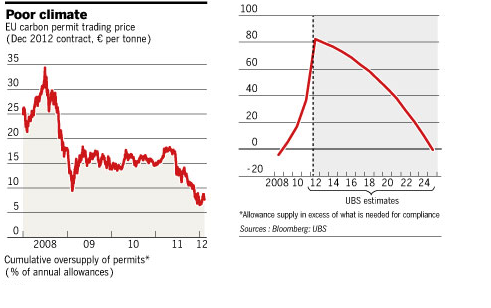
The market has suffered other indignities in its brief history, from value added tax frauds worth billions of euros to the cybertheft of millions of permits from companies’ electronic accounts. But, because it calls into question the fundamental workings of the market itself, the price slide may be its most serious affliction.
"The carbon price is far lower than we estimated it to be when we adopted the whole system,” says Martin Lidegaard, climate and energy minister for Denmark. "I think it’s fair to say that the situation is not sustainable in the long term.”
Now, a debate is brewing in Brussels about how to fix the market – one that is dividing corporate Europe. On one side stand Mr Teyssen and a coalition of companies that have invested in low-carbon technology, which are lobbying for the European Commission, the EU’s executive arm, to intervene immediately to prop up prices.
One of them is Shell, which has bet big on carbon capture, one of the most ambitious
green technologies on the drawing board. Rather than spewing emissions into the
atmosphere, companies would capture and bury them. Those plans were hatched
under an assumption that carbon prices would reach more than €30.
"There’s no doubt that the investment case for carbon capture and storage is worse if the carbon price is lower, and we may see fewer projects go forward in the future because of it,” says Graeme Sweeney, Shell’s executive vice-president in charge of carbon, who has called for the introduction of a minimum price to give investors greater certainty.
Instead the Commission is in considering a plan - based on last Tuesday’s vote – to set aside millions of permits to help stabilise prices. "To preserve this truly European and cost-effective policy tool, we have to consider and we are considering how to strengthen the ETS,” says Connie Hedegaard, climate commissioner.
But steelmakers and other heavy industries are dead set against intervention. If the system was created to introduce market incentives into environmental policy, they argue, meddling with prices undermines its raison d’être. One industrial lobbyist denounces it as moving the goalposts in the middle of a match.
Even analysts who worry about climate change are wary of intervention. "Low prices are not indicative of a broken
market any more than high prices,” says Trevor Sikorski, director of carbon
markets at Barclays Capital, pointing to the dramatic swing in oil prices in
the past decade.
For Europe, getting the market right is central to its loft aspiration of "decarbonising” its economy by the middle of the century. The ETS is also being closely studied by China and other nations toying with their own carbon markets, which might one day be bound together to form a global trading system.
The market’s success is also a matter of global
prestige. The debt crisis that has stalked the bloc for two years has tarnished its most ambitious
project – the single currency – while sapping its self-confidence and
diminishing its stature in the world.
Last year, an EU-China summit offered a vivid snapshot of the bloc’s changed circumstances: EU leaders arrived in Beijing hat in hand, hoping to persuade China to contribute a portion of its vast foreign reserves to help halt the euro crisis – a mission no doubt made more awkward by the EU - China confrontation over the carbon market.
Well before the crisis, the EU – lacking a common military or a coherent foreign policy – seized on climate policy as one area in which it could lead the world and project "soft power”. The carbon market is the machinery that underpins that promise. In essence it is a mechanism borrowed from the US, which introduced a cap-and-trade approach to contain the industrial pollution fouling lakes and rivers in the 1990s. The appeal was its seeming simplicity: all policymakers had to do was place a cap on the bloc’s annual emissions, then stand back and let companies find the most cost-effective way to reduce them. They could invest in cleaner technology or opt to buy permits on the secondary market from more efficient rivals. Companies embraced the idea because they believed it would be less intrusive than other forms of regulation.
However, the EU’s experience reveals the problem with relying on policymakers to make the long-term projections that underlie such a complex and sprawling market – particularly in the midst of wrenching economic changes and relentless pressure from corporate lobbyists.
"The ETS is a joke,” says Per Lekander, a UBS analyst who estimates that the market is saturated with 35-48 per cent more permits than are needed to meet current compliance requirements. It will remain awash in excess permits at least until 2025, he predicts. "The theory is good – it’s just when it gets exposed to political reality” that it goes wrong.
The first brush with reality came at the market’s inception. In an effort to overcome business opposition, the European Commission, the EU’s executive arm, set a generous cap and allowed national governments to lavish favoured industries with free permits. In some sectors, such as electricity, companies subsequently reaped millions of euros in windfall profits by passing on the market price of the permits to customers even when they themselves paid nothing for them.
Successive reforms have sought to clamp down on free permits. From 2013, more than half will be sold at auction, rising to 100 per cent for the power sector. Brussels, not the member states, will be running the show.
But those reforms have been undermined by a historic recession that has damped industrial activity – and carbon emissions – across the continent. It has also sharpened the arguments of businesses threatening job losses to persuade politicians to soften rules. "Corporate lobbying has been tremendously effective,” says Chris Davies, a British Liberal Democrat who sits on the European parliament’s environment committee. "Politicians are very nervous about doing anything that could close an industry or cost jobs.”
Somewhat perversely, one of the greatest emerging threats to the carbon market is another good EU environmental cause. The bloc is stepping up efforts to improve energy efficiency, which environmentalists and economists laud as the most cost-effective way to combat global warming. But success will inevitably mean lower overall emissions and a further sag in the carbon price.
To Bas Eickhout, a Dutch member of the European Parliament’s Green group, its fundamental flaw springs from a confused birth in which politicians failed to agree on its purpose. "Did we design it just to have an efficient tool to set a carbon price or to spur innovation?” he asks. "That’s the fundamental political debate.”
(source: IENE’s SOUTH-EAST EUROPE ENERGY BRIEF- Monthly Analysis, Issue No 85 • February 2013)
